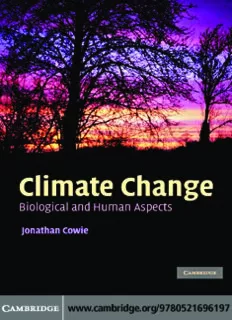
Climate change : biological and human aspects PDF
Preview Climate change : biological and human aspects
This page intentionally left blank CLIMATE CHANGE: BIOLOGICAL AND HUMAN ASPECTS In recent years climate change has become recognised as the foremost envir- onmental problem of the twenty-first century, and a subject of considerable debate. Not only will climate change affect the multi-billion dollar energy strategies of countries worldwide, but it could also seriously affect many species, including our own. Written in an accessible style, this textbook pro- videsabroadreviewofpast,presentandlikelyfutureclimatechangefromthe viewpoints of biology, ecology and human ecology. It is thoroughly refer- enced, allowing readers, if they wish, to embark on their own more specialist studies. A fascinating introduction to the subject, this textbook will be of interest to a wide range of people, from students in the life sciences who need a brief overview of the basics of climate science, to atmospheric science, geography andenvironmentalsciencestudentswhoneedtounderstandthebiologicaland human ecological implications of climate change. It will also be a valuable reference for those invol ved in environmental monitoring, conservation, policy-makingandpolicylobbying. JONATHAN COWIE hasspent many years conveyingthe viewsof biological science learned societies to policy-makers. His earlier postgraduate studies related to energy and the environment, and he is a former Head of Science PolicyandBooksattheInstituteofBiology(UK).HeisauthorofClimateand HumanChange:DisasterorOpportunity(ParthenonPublishing,1998). CLIMATE CHANGE Biological and Human Aspects JONATHAN COWIE CAMBRIDGE UNIVERSITY PRESS Cambridge, New York, Melbourne, Madrid, Cape Town, Singapore, São Paulo Cambridge University Press The Edinburgh Building, Cambridge CB2 8RU, UK Published in the United States of America by Cambridge University Press, New York www.cambridge.org Information on this title: www.cambridge.org/9780521696197 © J. Cowie 2007 This publication is in copyright. Subject to statutory exception and to the provision of relevant collective licensing agreements, no reproduction of any part may take place without the written permission of Cambridge University Press. First published in print format 2007 ISBN-13 978-0-511-55673-9 eBook (Dawsonera) ISBN-13 978-0-521-69619-7 paperback Cambridge University Press has no responsibility for the persistence or accuracy of urls for external or third-party internet websites referred to in this publication, and does not guarantee that any content on such websites is, or will remain, accurate or appropriate. Contents Introduction pagexi Acknowledgements xv 1 Anintroductiontoclimatechange 1 1.1 Weatherorclimate 2 1.2 Thegreenhouseeffect 3 1.3 Thecarboncycle 10 1.4 Naturalchangesinthecarboncycle 20 1.5 Pacemakeroftheglacial–interglacialcycles 22 1.6 Non-greenhouseinfluencesonclimate 28 1.7 Thewatercycle,climatechangeandbiology 31 1.8 Fromtheorytoreality 33 1.9 References 35 2 Principalindicatorsofpastclimates 37 2.1 Terrestrialbioticclimaticproxies 39 2.1.1 Tree-ringanalysis(dendrochronology) 39 2.1.2 Isotopicdendrochronology 43 2.1.3 Leafshape (morphology) 45 2.1.4 Leafphysiology 46 2.1.5 Pollenandsporeanalysis 47 2.1.6 Speciesasclimateproxies 50 2.2 Marinebioticclimaticproxies 53 2.2.1 18Oisotopeanalysisofforamsandcorals 53 2.2.2 Alkenoneanalysis 58 2.3 Non-bioticindicators 59 2.3.1 Isotopicanalysisofwater 59 2.3.2 Boreholes 61 2.3.3 Carbondioxideandmethanerecordsas palaeoclimaticforcingagents 61 2.3.4 Dustasanindicatorofdry–wethemisphericclimates 63 2.4 Otherindicators 63 v vi Contents 2.5 Interpretingindicators 64 2.6 Conclusions 64 2.7 References 65 3 Pastclimatechange 67 3.1 EarlybiologyandclimateoftheHadeanandArcheaen eons(4.6–2.5billionyearsago,bya) 67 3.1.1 Thepre-bioticEarth(4.6–3.8bya) 67 3.1.2 TheearlybioticEarth(3.8–2.3bya) 68 3.2 Majorbio-climaticeventsoftheProterozoiceon (2.5–0.542bya) 71 3.2.1 Earthintheanaerobic–aerobictransition (2.6–1.7bya) 71 3.2.2 TheaerobicEarth(from1.7bya) 74 3.3 Majorbio-climaticeventsofthepre-QuaternaryPhanerozoic (540–2mya) 77 3.3.1 Late-Ordovicianextinction(455–435mya) 77 3.3.2 Late-Devonianextinction(365–363.5mya) 78 3.3.3 Vascularplantsandtheatmosphericdepletion ofcarbondioxide(350–275mya) 79 3.3.4 Permo–Carboniferousglaciation(330–250mya) 81 3.3.5 End-Permianextinction(251mya) 83 3.3.6 End-Triassicextinction(205mya) 85 3.3.7 Toarcian(early(latelower)Jurassic)extinction (183mya) 86 3.3.8 Cretaceous–Tertiaryextinction(65.5mya) 87 3.3.9 Eoceneclimaticmaximum(55–54.8mya) 90 3.3.10 Eocene–O ligoceneextinction(approximately35mya; or33.9mya?) 101 3.3.11 LateMioceneexpansionofC grasses(14–9mya) 103 4 3.4 Summary 108 3.5 References 109 4 TheOligocenetotheQuaternary:climateandbiology 113 4.1 TheOligocene(33.9–23.03mya) 113 4.2 TheendMiocene(9–5.3mya) 115 4.3 ThePliocene(5.3–1.8mya) 116 4.4 Thecurrenticeage 120 4.5 Thelastglacial 126 4.5.1 Overviewoftemperature,carbondioxideandtiming 126 4.5.2 Iceandsealevel 129 4.5.3 Temperaturechangeswithintheglacial 130 Contents vii 4.5.4 Biologicalandenvironmentalimpactsofthelastglacial 141 4.6 Interglacialsandthepresentclimate 148 4.6.1 Previousinterglacials 148 4.6.2 TheAllerød,BøllingandYoungerDryas (14600–11600yearsago) 152 4.6.3 TheHolocene(11500yearsago–theIndustrial Revolution) 159 4.6.4 Biologicalresponsetothelastglacial,LGMand Holocenetransition 168 4.7 Summary 178 4.8 References 179 5 Presentclimateandbiologicalchange 184 5.1 Recentclimatechange 184 5.1.1 ThelatterhalfoftheLittleIceAge 184 5.1.2 Twentieth-centuryclimate 188 5.1.3 Twenty-first-centuryclimate 189 5.1.4 TheHoloceneinterglacialbeyondthetwenty-first century 189 5.1.5 Holocenesummary 191 5.2 HumanchangearisingfromtheHoloceneclimate 193 5.2.1 Climaticimpactsonearlyhumancivilisations 193 5.2.2 TheLittleIceAge’shumanimpact 194 5.2.3 Increasingtwentieth-centuryhumanclimatic insulation 200 5.3 Climateandbusinessasusualinthetwenty-firstcentury 201 5.3.1 IPCCBusinessasUsual 201 5.3.2 Uncertaint iesandtheIPCC’sconclusions 213 5.4 Currenthumaninfluencesonthecarboncycle 222 5.4.1 Carbondioxide 222 5.4.2 Methane 226 5.4.3 Halocarbons 227 5.4.4 Nitrousoxide 228 5.5 References 228 6 Currentwarmingandlikelyfutureimpacts 231 6.1 Currentbiologicalsymptomsofwarming 231 6.1.1 Currentborealdendrochronologicalresponse 231 6.1.2 Currenttropical-rainforestresponse 233 6.1.3 Somebiologicaldimensionsoftheclimatic-change fingerprint 235 6.1.4 Phenology 238 viii Contents 6.1.5 Biologicalcommunitiesandspeciesshift 240 6.2 Casestudy:climateandnaturalsystemsintheUSA 253 6.3 Casestudy:climateandnaturalsystemsintheUK 264 6.4 Biologicalresponsetogreenhousetrendsbeyondthe twenty-firstcentury 275 6.5 Possiblesurpriseresponsestogreenhousetrendsinthe twenty-firstcenturyandbeyond 276 6.5.1 Extremeweatherevents 276 6.5.2 Greenhousegases 279 6.5.3 Sea-levelrise 280 6.5.4 Methanehydrates(methaneclathrates) 289 6.5.5 Volcanoes 293 6.5.6 Oceanicandatmosphericcirculation 296 6.5.7 Oceanacidity 301 6.5.8 Theprobabilityofsurprises 304 6.6 References 305 7 Thehumanecologyofclimatechange 310 7.1 Population(past,presentandfuture)andits environmentalimpact 310 7.1.1 Populationandenvironmentalimpact 310 7.1.2 Pastandpresentpopulation 319 7.1.3 Futurepopulation 322 7.1.4 Food 325 7.1.5 Impactonotherspecies 327 7.2 Energysupply 330 7.2.1 Energysupply–thehistoricalcontext 331 7.2.2 Futureene rgysupply 337 7.3 Humanhealthandclimatechange 343 7.3.1 Healthandweatherextremes 345 7.3.2 Climatechangeanddisease 353 7.3.3 Floodingandhealth 361 7.3.4 Droughts 368 7.4 Climatechangeandfoodsecurity 368 7.4.1 Pastandpresentfoodsecurity 368 7.4.2 Futurefoodsecurityandclimatechange 371 7.5 Thebiologyofreducinganthropogenicclimatechange 377 7.5.1 Terrestrialphotosynthesisandsoilcarbon 378 7.5.2 Manipulatingmarinephotosynthesis 383 7.5.3 Biofuels 384 7.6 Summaryandconclusions 387
Description: